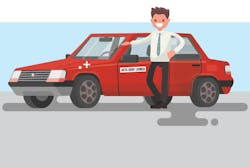It’s a common hassle for customers facing a major repair: They drop their cars off and are subsequently left without the necessary transportation to go about their daily lives.
Anything that can alleviate this problem, like a loaner fleet, is a welcome service for these customers, but, as a shop owner, it’s difficult to know whether it’s best for you and your customer base.
Ratchet+Wrench talked to Seth Thorson, owner of Minnesota-based Eurotech Auto Service, who described how and why he started his loaner program. Michael Graham, president of aftermarket insurance broker AutoRisk, weighed in on some major liability issues with starting and maintaining a loaner fleet program.
Benefits of the program:
Eurotech is located in New Brighton, a Twin Cities suburb. Thorson says the shop is a bit out of the way for people looking to bring their cars in, so he needed to offer alternative forms of transportation for those facing a major repair.
Thorson says his company knew from the beginning that pairing with a rental company wouldn’t fit with its model. Thorson was disinterested with the paperwork and uncertainty that pairing with the local Enterprise would have brought his business, as he says the company was almost always out of cars.
He says that having a fleet allows him and his staff to be flexible with its hours and overbook for appointments. Eurotech is closed on weekends, so the option of giving a loaner car to a customer facing a lengthy repair is a nice bonus.
“I know that once I have the car here, I can usually tell the customer that, if something happens, they can use the loaner car,” Thorson says.
The fact that loaner services are included with the cost of repairs allows Thorson and the rest of his team to convert customers who are on the fence, and is a great differentiator from other businesses without the service.
“If something goes wrong or out of your control, you can get them in a car,” Thorson says.
What you need to set it up:
Depending on the shop and amount of technicians you have, you may need anywhere from two to 10 loaner vehicles to service your customer base. Eurotech brings in about 180–200 cars per month into its 7,800-square-foot shop, so its eight-car fleet generally keeps up with demand.
When acquiring these cars, Thorson went about it two separate ways over the 10-year lifespan of Eurotech’s program. The shop started its fleet by purchasing older Mercedes and BMWs from clients unwilling to pay for extensive repairs. When those started taking too much time and money to repair, they started leasing Volkswagen Jettas and BMWs from local dealerships.
To cover the cost of operation, Thorson set up a transportation budget, which he says is anywhere from $1,500–2,000 per month. This covers the maintenance and leasing of his loaner vehicles, along with his shuttle and ride-sharing programs.
Maintaining your fleet:
Before leasing the vehicles, Thorson says he spent about $150$200 monthly per car maintaining the fleet. However, Thorson said the constant in-house repairs ate into his revenue, especially when his shop was at capacity.
Since Thorson currently leases the entirety of his loaner fleet (most of which are under maintenance by the manufacturers), maintenance for his vehicles simply involves taking his car down to the dealership. Thorson says this is the best way to avoid maintenance costs and avoid major liability issues.
Liability issues:
Not every insurance company would cover his fleet, so Thorson lost some ability to shop around for better coverage rates.
This also creates liability issues where, depending on the state, your auto shop can be held responsible for any damage incurred by the driver.
“If I loan you a car, I’m basically loaning you my insurance,” Graham says.
Most states allow the shop owner to transfer comprehensive and collision insurance to the borrower in an accident, but with most states, including Graham’s home state of Colorado, liability cannot be transferred.
In Thorson’s home state of Minnesota, he is able to transfer liability up to the owner’s limit. Thorson makes sure that anyone who uses one of Eurotech’s loaner cars signs a loaner agreement, which transfers all insurance onto the borrower. He carries additional umbrella insurance for any liability damage above the borrower’s limit.
Alternative: Shuttle Service
—
Steve Mancinelli, owner of Mancinelli’s Auto Repair Center in Denver, has had a shuttle program in his shop for over 20 years now (prior to that he gave rides to customers in his own personal truck). Mancinelli now doubles as the shop’s designated shuttle driver in its Dodge Caravan. He gives customers a ride home or to the office in the morning, and back to the shop in the afternoon when their cars are repaired, as long as they’re within a five-mile radius of the shop.
Mancinelli views his time transporting customers as a way to get to know his customer base and build loyalty, and says it can be a great way to advertise your shop’s services. A few years ago, he actually turned the van into what he calls “a rolling billboard.”
"I had the van completely wrapped with the shop logo and some pictures. It’s very distinguishable—people know where it’s coming from,” Mancinelli says.
One drawback to a shuttle program is that you’re at the mercy of the oil industry to cover your own gas costs. Now he spends roughly $100–125 per month in fuel costs, but when fuel prices creeped up past $4 per gallon about 10 years ago, Mancinelli says he almost had to scrap the program. Aside from the gas costs, Mancinelli says he spends about $270 per year in basic insurance for his shuttle.Alternative: Rental Service
—
Pairing with a rental service like Enterprise or Hertz can be an effective way to loan vehicles to your customers without setting up your own program or dealing with insurance.
Everything changes state by state, but from a liability standpoint, Graham says it can be easiest to pair with a bigger company like Hertz or Enterprise. All of the liability gets shifted to the rental company, and your shop won’t have to directly face the consequences of a bad driver.
If you don’t have a rental car company in close proximity, it’s nearly impossible to make this work effectively. If you choose to pick up the tab for rental programs, it will run you about $30–$35 per day for each car you loan out.
Alternative: Uber/Lyft
—
Phil Carpenter, general manager of Denver-based Urban Autocare, has used Lyft’s ride-sharing services for over a year now. It serves as an alternative to his shuttle service and the rental company he pairs with, and works well for customers facing shorter repair times.
Urban Autocare sits on the outskirts of Denver, in an area with a very dense population. Most of Carpenter’s clients live or work within close proximity to his store, so he says an Uber ride to and from the shop is generally an effective mode of transportation.
“It costs quite a bit less to put somebody in a Lyft and be done with it,” Carpenter says. “And customers are very grateful when you pay for it.”
One drawback with the ridesharing services, however, is that you don’t know if a trustworthy person is transporting your customer, and if they’ll treat them with respect.
Carpenter says he spends about $30–$50 per week paying for the ride-sharing services, which he fits under his monthly marketing budget.

